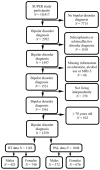Reaction Time and Visual Memory in Connection to Alcohol Use in Persons with Bipolar Disorder
- PMID: 34573174
- PMCID: PMC8467646
- DOI: 10.3390/brainsci11091154
Reaction Time and Visual Memory in Connection to Alcohol Use in Persons with Bipolar Disorder
Abstract
The purpose of this study was to explore the association of cognition with hazardous drinking and alcohol-related disorder in persons with bipolar disorder (BD). The study population included 1268 persons from Finland with bipolar disorder. Alcohol use was assessed through hazardous drinking and alcohol-related disorder including alcohol use disorder (AUD). Hazardous drinking was screened with the Alcohol Use Disorders Identification Test for Consumption (AUDIT-C) screening tool. Alcohol-related disorder diagnoses were obtained from the national registrar data. Participants performed two computerized tasks from the Cambridge Automated Neuropsychological Test Battery (CANTAB) on A tablet computer: the 5-choice serial reaction time task, or reaction time (RT) test and the Paired Associative Learning (PAL) test. Depressive symptoms were assessed with the Mental Health Inventory with five items (MHI-5). However, no assessment of current manic symptoms was available. Association between RT-test and alcohol use was analyzed with log-linear regression, and eβ with 95% confidence intervals (CI) are reported. PAL first trial memory score was analyzed with linear regression, and β with 95% CI are reported. PAL total errors adjusted was analyzed with logistic regression and odds ratios (OR) with 95% CI are reported. After adjustment of age, education, housing status and depression, hazardous drinking was associated with lower median and less variable RT in females while AUD was associated with a poorer PAL test performance in terms of the total errors adjusted scores in females. Our findings of positive associations between alcohol use and cognition in persons with bipolar disorder are difficult to explain because of the methodological flaw of not being able to separately assess only participants in euthymic phase.
Keywords: alcohol; bipolar disorder; cognition; reaction time; visual memory.
Conflict of interest statement
The authors declare no conflict of interest.
Figures
References
-
- Roux P., Etain B., Cannavo A.S., Aubin V., Aouizerate B., Azorin J.M., Bellivier F., Belzeaux R., Bougerol T., Cussac I., et al. Prevalence and determinants of cognitive impairment in the euthymic phase of bipolar disorders: Results from the FACE-BD cohort. Psychol. Med. 2019;49:519–527. doi: 10.1017/S0033291718001186. - DOI - PubMed
-
- Roux P., Raust A., Cannavo A.S., Aubin V., Aouizerate B., Azorin J.M., Bellivier F., Belzeaux R., Bougerol T., Cussac I., et al. Associations between residual depressive symptoms, cognition, and functioning in patients with euthymic bipolar disorder: Results from the FACE-BD cohort. Br. J. Psychiatry J. Ment. Sci. 2017;211:381–387. doi: 10.1192/bjp.bp.117.201335. - DOI - PubMed
-
- Bourne C., Aydemir Ö., Balanzá-Martínez V., Bora E., Brissos S., Cavanagh J.T., Clark L., Cubukcuoglu Z., Dias V.V., Dittmann S., et al. Neuropsychological testing of cognitive impairment in euthymic bipolar disorder: An individual patient data meta-analysis. Acta Psychiatr. Scand. 2013;128:149–162. doi: 10.1111/acps.12133. - DOI - PubMed
Grants and funding
LinkOut - more resources
Full Text Sources


